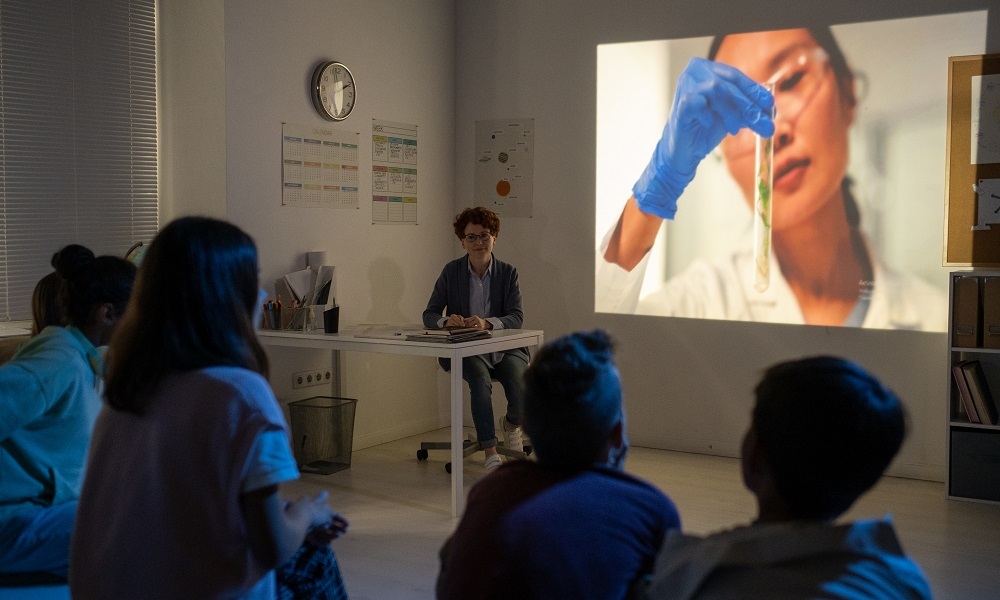Since the pandemic began in 2019, video consumption – in particular watching short form video content – has risen significantly in K-12 learning environments. These changing video consumption patterns in education have inspired a growing body of research focused on measuring video’s effectiveness as a learning aid.
Despite limitations in existing studies, there is some promising research indicating that video can enhance learning and can be a highly effective educational tool. It has been associated with an increase in student and teacher satisfaction (Kay & Edwards, 2012), motivation (Merkt et al., 2011) and confidence (Cook et al., 2017), and in some contexts, stronger academic performance (Boster et al., 2006).
Even though video is heavily used in the K-12 context, much of the research to date has focused on higher education settings. It’s fair to say that the conclusions drawn from higher education studies may not be as relevant for schools.
Earlier this year, Professor of Digital Futures in the Faculty of Education at Monash University, Michael Henderson, and I conducted a scoping study of instructional video research. The literature review involved analysing 7 systematic reviews that encompassed 7,170 empirical research studies conducted over the last 50 years. Of those, only 77 of the papers included in those reviews were focused on K-12 learners, the focus of our review. The review of the literature identified 3 key factors that led to impact – video design, learning design and learner characteristics. I’ve distilled these findings into 3 key takeaways that educators can use now to improve the way they use video in the classroom.
1. Some video design principles have more support in research than others
In this literature review we defined video design as the design elements that are used in the creation of instructional video. Research on video design has identified dozens of design principles. However, in a K-12 educational context, not all of these multimedia design principles are supported by the overall body of research, and some have more support than others. In our review, we examined 15: coherence, redundancy, video length reduction, transience, signalling, segmentation, worked example, interactivity, guided discovery, integrated learning activities, learner control, the embodiment principle, emotional design, and storytelling. Here is what we discovered:
- Of the 15 design principles we examined, the following were shown to have the strongest support in the literature: coherence, integrating learning activities, the embodiment principle, learner control, video length reduction and segmenting.
- Design principles are often more effective when combined with at least one other. For example: the embodiment principle and signalling (Yung & Pass, 2015). However, it’s uncertain whether it’s the combination of principles or a single principle alone that is effective.
What does this mean for educators?
There is no single design principle or magic formula for the perfect combination of principles that will engage students and increase knowledge acquisition, retention and transfer. However, by understanding video design principles, educators can choose or create videos that have the right combination of principles that meet their student’s unique learning needs. Start with looking for, or creating videos that have
- a clear purpose and goal,
- don’t have extraneous or seductive details included, and
- have pauses and signals to help students understand and make sense of what they are watching.
2. A ‘play and pray’ approach to video won’t deliver learning outcomes: learning design needs careful consideration, too.
Learning design refers to the strategies and interventions used with video to enhance its effectiveness in a learning setting. Of the papers we reviewed, learning design interventions such as pre-training, flipped classrooms, and prompting and modelling (and their associated sub-categories) were shown to increase academic achievement, motivation, and engagement, and contributed to the development of social, emotional, self-regulation and life skills. Here is what we discovered about those interventions:
Flipped classrooms
Using video to convey course content before class has been shown to be more effective than using text-based material. Studies where flipped classroom interventions used videos reported that students showed increased subject skill development, improved academic performance, greater motivation in their studies in general, a more positive attitude to the subject and greater social interaction before class. However, the research also showed that these outcomes are only possible if certain barriers are removed: the video needs to be short, students must have access to the videos at home, and students need to be motivated to complete the pre-class tasks.
Video modelling and prompting
These teaching methods instruct students to watch a short video depicting the target skill and are asked either to apply what they saw in the video at the end (modelling) or are shown a sequence of steps and are prompted to perform the actions after each step (prompting).
Pre-training
This intervention works on the suggestion that people learn more deeply from a multimedia message when they know the names and characteristics of the main concepts (Mayer, 2014). In one study, pre-training (induction) for students about how to use video for an activity resulted in what the scholars claimed was a ‘substantial impact’ on the examination performance of 3,932 elementary and middle school Mathematics, Science and Social Studies students. The improvement of students in the experimental group exceeded the control group by 12.6% (Boster et al, 2006; Boster et al. 2007). It also reduced the time students took to answer post-test questions.
What does this mean for educators?
Simply playing a video, or using it as an instructional substitute, isn’t enough to guarantee engagement with a topic, knowledge acquisition, learning transfer and knowledge recall. Videos and learning interventions need to be considered as partners that enhance the effectiveness of each other. When deciding when and how to use video, educators need to consider the topic being taught, the learning styles of their students, and their motivation to complete different types of tasks. Some students may do better if they are given pre-training about the topic or the technology being used, some may require a step-by-step approach with a fair amount of praise and error correction, while others may be motivated enough for a flipped classroom approach.
3. Learner characteristics may not have as much influence on the impact of video in K-12 education as you might think.
Certain characteristics can influence how people learn, and there are many theories and models that try to explain how people learn based on personal preferences, individual strengths, and factors like motivation and learning environment.
While all of the papers in the review described the various characteristics of the studies, for example age, most did not discuss those characteristics as a moderator in the outcomes of the studies. It is therefore difficult to tell how influential they really are when it comes to choosing and using instructional videos.
That said, we found the following findings interesting.
- Age: video has been shown to have a positive impact on learner enjoyment at all ages. While this doesn’t necessarily translate into positive learning outcomes, enjoyment is an important factor in motivating students to learn.
- Gender: a much-researched topic for learning in general, this is a neglected area in research about video. However, some researchers have observed that videos may be more effective for males than females when there are more males in the class, and when video is used with a variety of other activities and learning interventions.
- Intrinsic motivation: while not found to be an important moderating factor in the impact of video on K-12 education, intrinsic motivation can be increased by offering students practice activities and interactive simulations as part of the video experience, and greater autonomy over which learning experiences they can participate in at revision time.
Using video at the right time and in the right way will take trial and error. However, if educators work together with colleagues at their school and in the broader education community to share knowledge about what does and doesn’t work, it will make using video even more impactful for learners everywhere.
References
Boster, F. J., Meyer, G. S., Roberto, A. J., Inge, C., & Strom, R. (2006). Some effects of video streaming on educational achievement. Communication Education, 55(1), 46-62. http://doi.org/10.1080/03634520500343392
Boster, F. J., Meyer, G. S., Roberto, A. J., Lindsey, L, Smith, R., Inge, C., & Strom, R. (2007). The Impact of Video Streaming on Mathematics Performance. Communication Education, 56(2), 134-144. http://doi.org/10.1080/03634520601071801
Brame, C.J. (2017). Effective educational videos: Principles and Guidelines for Maximising Student Learning from Video Content. Life Sciences Education, 15(4), 16 https://doi.org/10.1187/cbe.16-03-0125
Cook, S. W., Friedman, H. S., Duggan, K. A., Cui, J., & Popescu, V. (2017). Hand gesture and mathematics learning: lessons from an Avatar. Cognitive science, 41(2), 518-535. https://onlinelibrary.wiley.com/doi/full/10.1111/cogs.12344
Fyfield, M., Henderson, M., & Phillips, M. (2022). Improving instructional video design: A systematic review. Australasian Journal of Educational Technology, 1–29. https://doi.org/10.14742/ajet.7296
Kay, R. H., & Edwards, J. (2012). Examining the use of worked example video podcasts in middle school mathematics classrooms: a formative analysis/Étude surl’utilisation de podcasts d’exemples pratiques dans des classes de mathématiques àl’école secondaire de premier cycle. Canadian Journal of Learning and Technology/La revue canadienne de l’apprentissage et de la technologie, 38(3). https://doi.org/10.21432/T2PK5Z
Mayer, R. E. (2014a). Cognitive theory of multimedia learning. In R. E. Mayer (Ed.) The Cambridge handbook of multimedia learning (pp. 43–71). Cambridge University Press. https://doi.org/10.1017/CBO9781139547369.005
Mayer, R. E. (2014b). Principles based on social cues in multimedia learning: Personalization, voice, image, and embodiment principles. In R. E. Mayer (Ed.), The Cambridge handbook of multimedia learning (pp. 345–368). Cambridge University Press. https://doi.org/10.1017/CBO9781139547369.017
Merkt, M., Weigand, S., Heier, A., & Schwan, S. (2011). Learning with videos vs. learning with print: The role of interactive features. Learning and Instruction, 21(6), 687-704. https://doi.org/10.1016/j.learninstruc.2011.03.004
Yung, H. I., & Paas, F. (2015). Effects of cueing by a pedagogical agent in an instructional animation: A cognitive load approach. Educational Technology & Society, 18(3), 153-160. https://www.jstor.org/stable/jeductechsoci.18.3.153
Tara Walsh says, ‘simply playing a video, or using it as an instructional substitute, isn’t enough … videos and learning interventions need to be considered as partners that enhance the effectiveness of each other’.
Reflect on the last time you used a video in the classroom to help students understand a concept. What considerations did you make when choosing which video to show students? Did you consider the video design, or think about how you could best utilise other teaching techniques, like modelling or flipped learning?



